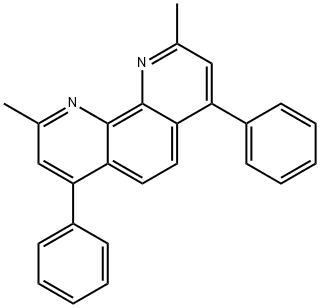| Identification | More | [Name]
Bathocuproin | [CAS]
4733-39-5 | [Synonyms]
2,9-DIMETHYL-4,7-DIPHENYL-1,10-PHENANTHROLINE
2-DIMETHYL-4,7-DIPHENYL-1,10-PHENANTHROLINE
4,7-DIPHENYL-2,9-DIMETHYL-1,10-PHENANTHROLINE
BATHOCUPROIN
BATHOCUPROINE
BLANC FIXE XR
TIMTEC-BB SBB008863
10-Phenanthroline,2,9-dimethyl-4,7-diphenyl-1
2,9-Dimethyl-4,7-diphenyl-1,10
2,9-dimethyl-4,7-diphenyl-10-phenanthroline
BATHOCUPROIN R. G.
BathocuproineGr
BATHOCUPROINE, REAG.
BATHOCUPROINE REAGENT (ACS)
1,10-Phenanthroline, 2,9-dimethyl-4,7-diphenyl-
2,9-DIMETHYL-4,7-DIPHENYL-1,10-PHENANTHROLINE SUBLIMED HOLE BLOCKING MATERIAL
BATHOCUPROINE (2,9-DIMETHYL-4,7-DIPHENYL-1,10-PHENANTHROLINE)
Bathocuproine (refined product of D0711)
Bathocuproin, 98+%
BATHOCUPROIN extrapure AR | [EINECS(EC#)]
225-240-5 | [Molecular Formula]
C26H20N2 | [MDL Number]
MFCD00004972 | [Molecular Weight]
360.45 | [MOL File]
4733-39-5.mol |
| Chemical Properties | Back Directory | [Appearance]
Yellow powder | [Melting point ]
279-283 °C(lit.)
| [Boiling point ]
482.47°C (rough estimate) | [density ]
1.2408 (rough estimate) | [refractive index ]
1.7620 (estimate) | [storage temp. ]
Sealed in dry,Room Temperature | [solubility ]
Benzene (Slightly, Heated), DMSO (Slightly, Heated), Methanol (Slightly, Heated) | [form ]
Powder | [pka]
5.88±0.30(Predicted) | [color ]
Yellow | [Water Solubility ]
Soluble in methanol (36mg/100ml), ethanol, 2-propanol, bezene, and acetone. Partly miscible in water. | [λmax]
277 nm | [BRN ]
306714 | [InChI]
InChI=1S/C26H20N2/c1-17-15-23(19-9-5-3-6-10-19)21-13-14-22-24(20-11-7-4-8-12-20)16-18(2)28-26(22)25(21)27-17/h3-16H,1-2H3 | [InChIKey]
STTGYIUESPWXOW-UHFFFAOYSA-N | [SMILES]
N1C2C(=CC=C3C=2N=C(C)C=C3C2=CC=CC=C2)C(C2=CC=CC=C2)=CC=1C | [CAS DataBase Reference]
4733-39-5(CAS DataBase Reference) | [EPA Substance Registry System]
4733-39-5(EPA Substance) | [Description]
Bathocuproine (BCP) is a wide-band-gap material and has a high electron affinity. When it is embedded into organic electronic devices, bathocuproine acts as an exciton-blocking barrier?which prohibits exciton diffusion process?towards the Al electrode otherwise being quenched. One of the most commonly used buffer layer between acceptor and cathode layers is?bathocuproine. The introduction of the buffer layer can greatly improve the PCE of polymer organic solar cells.?BCP is one of the most popular hole-blocking layer materials that is used in organic electronics, including perovskite solar cells. | [Odor]
Light yellow powder |
| Safety Data | Back Directory | [Hazard Codes ]
Xn | [Risk Statements ]
R22:Harmful if swallowed.
R36/37/38:Irritating to eyes, respiratory system and skin .
R20/21/22:Harmful by inhalation, in contact with skin and if swallowed . | [Safety Statements ]
S24/25:Avoid contact with skin and eyes .
S36:Wear suitable protective clothing .
S26:In case of contact with eyes, rinse immediately with plenty of water and seek medical advice . | [WGK Germany ]
3
| [TSCA ]
Yes | [HS Code ]
29339990 |
| Questions And Answer | Back Directory | [Classification]
Electron-transport layer materials, Electron-injection layer materials, Hole-blocking layer materials, OFET, OLED, Organic Photovoltaics, Perovskite solar cells, Sublimed materials. | [Applications]
2,9-Dimethyl-4,7-diphenyl-1,10-phenanthroline, also known as Bathocuproine (BCP), is a wide-band-gap material and has a high electron affinity. When it is embedded into organic electronic devices, bathocuproine acts as an exciton-blocking barrier which prohibits exciton diffusion process towards the Al electrode otherwise being quenched. One of the most commonly used buffer layer between acceptor and cathode layers is bathocuproine. The introduction of the buffer layer can greatly improve the PCE of polymer organic solar cells. BCP is one of the most popular hole-blocking layer materials that is used in organic electronics, including perovskite solar cells.
It was demonstrated that a BCP buffer layer reduces nonradiative recombination of excitons at the C60 –Al interface. Its most important function is to establish an Ohmic contact between the C60 film and the Al electrode in photovoltaic devices.
|
| Hazard Information | Back Directory | [Chemical Properties]
Yellow powder | [Uses]
It is used as a reagent for the determination of copper. It acts as an exciton blocking barrier which prohibits excitons diffusion process towards the Al electrode otherwise being quenched. It is the most commonly used buffer layer between acceptor and cathode layer. | [General Description]
TGA/DSC Lot specific scans available upon request | [Purification Methods]
Purify it by recrystallisation from *benzene. [Smith & Wilkins Anal Chem 25 510 1953, Beilstein 23 III/IV 2160.] | [References]
[1] Mao, Lingling et al. “Role of Organic Counterion in Lead- and Tin-Based Two-Dimensional Semiconducting Iodide Perovskites and Application in Planar Solar Cells.” Chemistry of Materials 28 (2016): 7781–7792. |
|
|





